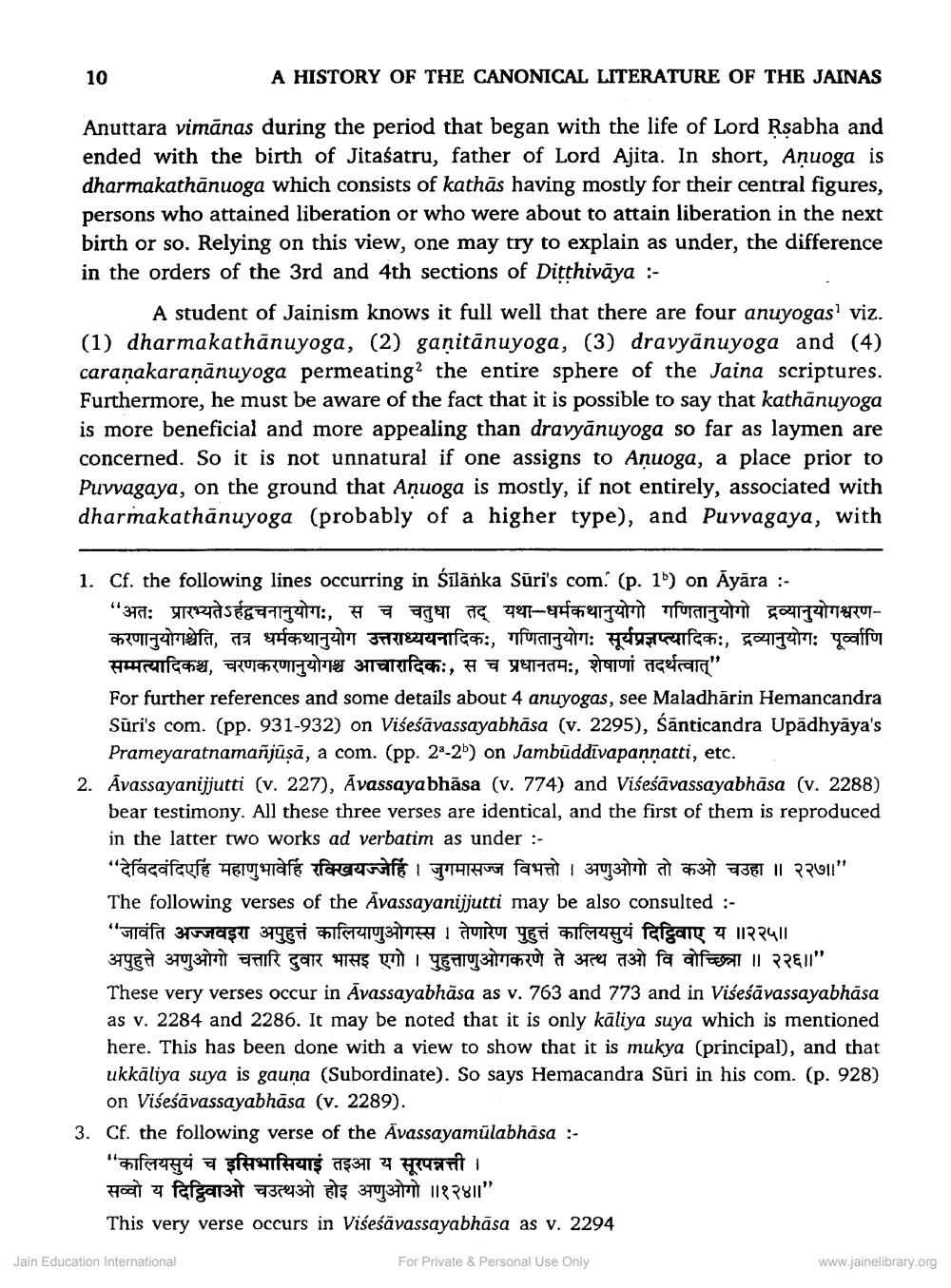________________
10
A HISTORY OF THE CANONICAL LITERATURE OF THE JAINAS
Anuttara vimănas during the period that began with the life of Lord Rsabha and ended with the birth of Jitaśatru, father of Lord Ajita. In short, Anuoga is dharmakathānuoga which consists of kathās having mostly for their central figures, persons who attained liberation or who were about to attain liberation in the next birth or so. Relying on this view, one may try to explain as under, the difference in the orders of the 3rd and 4th sections of Ditthivāya :
A student of Jainism knows it full well that there are four anuyogas' viz. (1) dharmakathānuyoga, (2) ganitānuyoga, (3) dravyānuyoga and (4) caranakaraṇānuyoga permeating the entire sphere of the Jaina scriptures. Furthermore, he must be aware of the fact that it is possible to say that kathānuyoga is more beneficial and more appealing than dravyānuyoga so far as laymen are concerned. So it is not unnatural if one assigns to Aņuoga, a place prior to Puvvagaya, on the ground that Aņuoga is mostly, if not entirely, associated with dharmakathānuyoga (probably of a higher type), and Puvvagaya, with
1. Cf. the following lines occurring in silãnka Sūri's com. (p. 16) on āyāra :
"अतः प्रारभ्यतेऽर्हद्वचनानुयोगः, स च चतुधा तद् यथा-धर्मकथानुयोगो गणितानुयोगो द्रव्यानुयोगश्वरणकरणानुयोगश्चेति, तत्र धर्मकथानुयोग उत्तराध्ययनादिकः, गणितानुयोगः सूर्यप्रज्ञप्त्यादिकः, द्रव्यानुयोगः पूर्वाणि सम्मत्यादिकश्च, चरणकरणानुयोगश्च आचारादिकः, स च प्रधानतमः, शेषाणां तदर्थत्वात्" For further references and some details about 4 anuyogas, see Maladhārin Hemancandra Sūri's com. (pp. 931-932) on Višeśāvassayabhāsa (v. 2295), śānticandra Upadhyāya's
Prameyaratnamañjūșā, a com. (pp. 22-2b) on Jambuddīvapannatti, etc. 2. Avassayanijjutti (v. 227), Āvassayabhāsa (v. 774) and Viseśāvassayabhāsa (v. 2288)
bear testimony. All these three verses are identical, and the first of them is reproduced in the latter two works ad verbatim as under :"देविंदवंदिएहिं महाणुभावेहि रक्खियज्जेहिं । जुगमासज्ज विभत्तो । अणुओगो तो कओ चउहा ॥ २२७॥" The following verses of the Āvassayanijjutti may be also consulted :"जावंति अज्जवइरा अपुहुत्तं कालियाणुओगस्स । तेणारेण पुहुत्तं कालियसुयं दिट्टिवाए य ॥२२५|| अपुहुत्ते अणुओगो चत्तारि दुवार भासइ एगो । पुहुत्ताणुओगकरणे ते अत्थ तओ वि वोच्छिना ॥ २२६॥" These very verses occur in Avassayabhāsa as v. 763 and 773 and in Viseśāvassayabhāsa as v. 2284 and 2286. It may be noted that it is only kāliya suya which is mentioned here. This has been done with a view to show that it is mukya (principal), and that ukkāliya suya is gauņa (Subordinate). So says Hemacandra Sūri in his com. (p. 928)
on Viśeśāvassayabhāsa (v. 2289). 3. Cf. the following verse of the Avassayamūlabhāsa :
"कालियसुयं च इसिभासियाई तइआ य सूरपन्नत्ती । सव्वो य दिट्टिवाओ चउत्थओ होइ अणुओगो ॥१२४॥" This very verse occurs in Višeśävassayabhāsa as v. 2294
Jain Education International
For Private & Personal Use Only
www.jainelibrary.org




